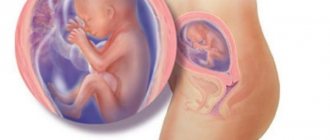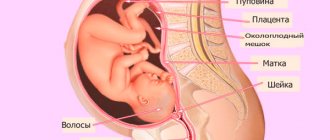Fetal development
Fetal size: your baby has grown well, now weighs 350 grams and is about 30 cm long.
This week his world got a little too small for him. Now he doesn't move as fast, since he doesn't have much space for a frisky lifestyle now. But he is still active. The baby continues to change his position, sometimes straight, sometimes upside down, and can even lie across. During this period, his restlessness in one position is normal.
In principle, if we compare it with last week, the baby’s growth has not changed much, but the weight is constantly increasing. After all, the baby is diligently accumulating subcutaneous fat, which will give him a normal body temperature after birth. His weight has also increased due to the active growth of his brain.
The baby's brain has developed to such an extent that your child explores his environment through touch, touching everything around him - the placenta, himself. He also really likes it when you stroke his tummy, he feels it and reacts to any touch.
The hair continues to grow, in some children it reaches such a length that it can be seen with the help of an ultrasound how it floats around; the hairs on the eyebrows are also clearly visible. Nails grow, when the baby is born, you will see how long his nails are. The baby's face already looks like its parents, the eyes are in their place, the ears are already fully formed, the final formation of the nose is underway, and the nasal cartilage is being formed.
In boys, this week the testicles begin to gradually descend from the pelvis into the scrotum.
Now your baby is fully beginning to prepare for vitality, that is, he is acquiring all the necessary skills to live independently.
Discharge
The nature of the discharge at this stage: light, light, in some cases with a barely noticeable sour odor. Their curd-like consistency, the presence of mucus, and yellowish-greenish tints are usually symptoms of infectious diseases and require immediate treatment.
The appearance of brownish, reddish or pinkish discharge this week is an alarming sign, symbolizing premature birth, placental abruption, marginal or central presentation of the fetus. Such conditions threaten the health of both the expectant mother and her baby, and therefore require emergency hospitalization.
How does a baby hear at 22 weeks of pregnancy?
During this period, perhaps the most interesting thing is that his hearing becomes perfect. How does a child hear? It is inside you and the sound reaches it differently.
Mom and her child
The baby is in constant noise. For association, imagine that you will be sitting in a noisy company in the loudest place. This is the background a baby hears every day. Noises are created by: heartbeat, how blood moves through the vessels, the work of other organs. However, these sounds create a feeling of comfort and security for the baby, so don’t worry!
How can a baby hear sounds from outside through such noise? And what sounds does he hear? The child hears those sounds that drown out the sounds of your body. Before sounds from the outside are heard, they pass through the walls of the abdomen, uterus and amniotic fluid. All the sounds that the baby hears from the outside seem muffled to him, this means that he will recognize his dad’s voice and listen with pleasure.
Every mother is interested in how her baby hears her. When you speak, sound waves travel throughout your body. Passing through the spine and pelvis, they are transmitted to the child. By the way, he not only hears your voice, but also feels its vibration.
Your baby can already distinguish sounds. Distinguishes dad's voice from other voices. And if external sounds are unpleasant to you, then he also reacts negatively to them. The child is completely ready to learn sounds. Now you can start instilling good habits in him. For example, play classical music for him.
Find out everything about baby's movements at 21 weeks
The movement of the child in the amniotic fluid is considered to be the movement of the child. This factor indicates that the development process of the little man is taking place.
At 21 weeks of pregnancy, a woman looks good: her hair is thick and shiny, her skin is clean and smooth. The breasts are slightly enlarged, and the tummy is rounded. During this period, appetite increases noticeably, so you need to carefully consider and balance your diet. There is no need to gain extra pounds - this can complicate the birth process.
You need to take walks in the fresh air.
At 21 weeks, an important indicator is the heartbeat and biparental size. At 21 weeks of pregnancy, slight movements are quite normal. During an ultrasound, the location of the placenta is noted, its thickness and maturity, and the amount of amniotic fluid are assessed.
At this stage, the development of the baby’s internal organs is checked. The child's height should be between 25-26 cm and weight up to 400 grams. If at 21 weeks of pregnancy there are no movements at all, this is a reason for additional examination. At this stage, the baby has grown enough for you to feel his movements.
Now the child seems thin, his main goal is to gain fat.
When do the first movements occur?
The baby begins to move immediately after the appearance of legs and arms. It’s just that in the early stages the mother cannot feel any movement. The most noticeable movements occur at 20 or 21 weeks of pregnancy. Each pregnant woman has a certain threshold of sensitivity; fat ones feel movements much later than thin ones.
The baby's movements at 21 weeks may resemble rolling or small pulsations. At such a time, the mother does not immediately understand that these are movements of the baby. From week 30, the tremors begin to really be felt.
What are movements?
So, movements at week 21 are 10 movements per day. When the mother is active and cheerful, the child is also active. Previously, there was an opinion that too frequent movements at 21 weeks indicate fetal hypoxia. This theory has now been disproven. Despite the fact that many mothers notice how the baby’s movements increase at 21 weeks when they are in stuffy and smoky rooms.
Mother's condition
At 21 weeks of pregnancy, the condition of the expectant mother can be assessed as vigorous and good. Women who gain weight quickly this week may experience varicose veins, hemorrhoids and constipation. Late toxicosis may occur. In this regard, to avoid edema, you need to measure your blood pressure as often as possible.
At this time, to identify disorders, a hormonal test is prescribed, which consists of three serum hormones.
Reaction to music
The question often arises whether the fetus reacts to music and other noises. Most scientists say it does.
Sometimes, when listening to certain music, mothers notice more intense movements at 21 weeks. Most often, kids prefer calm and quiet music, mainly classics. Such passions must be treated with respect.
Weak movements
So, if at 21 weeks of pregnancy there are weak movements, then you should immediately consult a doctor. Of course, if there are weak movements at 21 weeks of pregnancy, this is not very good. You need to consult your doctor. And if there are no movements at a later date, this is a good reason for an emergency examination.
To determine the condition of the fetus, cardiotocography will have to be performed. Of course, the heartbeat can be heard with a stethoscope, but cardiotocography is a more accurate technique. With its help, you can not only hear, but also record the heartbeat for subsequent analysis.
And this is done, first of all, for the child, since there is something in the mother’s body that interferes with his stay in it. In such a situation, it is better to help the child be born and mature outside the mother’s body.
What is useful to do? During this period, it is recommended to talk to the baby, sing songs to him and read to him. Now the fetus senses the mother’s state and tries to adapt to it. Already now he recognizes fear and joy. You should remain exclusively in a calm state. Anger and irritation may have a negative impact on the child’s nervous system. You need to add calcium to your diet, eat 5-6 times, and do not make your child feel hungry. During this period, you should limit yourself to eating meat and fish dishes, replacing them with dairy products. If a woman is 21 weeks pregnant and there is no movement, then she needs to see a doctor. The baby's movements at 21 weeks of pregnancy should be frequent and noticeable. If there are no movements at 21 weeks of pregnancy, then this is a serious reason to undergo additional examination.
Baby's movements
The week of pregnancy has come when you already definitely feel that your baby is moving, reacting to your touch and being active. Since he has grown up and there is not enough space for him, he moves about 15 times an hour. Of course, you don’t feel all of his movements.
You constantly listen to yourself. When your baby becomes quiet, you may begin to panic about why he is quiet and the baby is just sleeping. Most often, he falls asleep during the day when you are in motion; one might say, you rock him to sleep. Sleep lasts from two to three hours. The baby's active period of movement usually occurs around 10 pm. When you are already relaxed, lying quietly, he begins to behave actively.
You should consult a doctor if your baby does not move for more than 12 hours. In principle, you feel it periodically for 12 hours, in the morning, evening and afternoon. Although during the day you may not notice it, because you are doing something else, and it distracts your attention. In twelve hours you should feel about 10 movements.
The baby's movements are moderate, that is, he is not very active and does not subside for a long time. Expectant mothers, do not panic and do not constantly think about the baby’s movements. Get used to the new feeling that your baby is living his own life, and sometimes you feel its violent manifestation, that is, tremors. Over time, you will begin to distinguish when the child is active and when he sleeps. Listen to yourself, because you and your baby feel everything the same.
The baby begins to move, what should you pay attention to?
If you walk around and then lie down, the baby’s movements should then become more active thinkstockphotos
The first movements of a baby are perhaps the most exciting sensation for a pregnant woman. As a rule, a woman begins to feel the first movements of the child closer to the second half of pregnancy. What should be the nature of these movements and what should alert the expectant mother?
So, if this is the first pregnancy, then women begin to feel the first movements of the baby between 18 and 22 weeks. With a second pregnancy, the mother can feel this as early as 16 weeks. As a rule, for women, especially for those who are pregnant for the first time, this raises many questions: how often and how intensely should the child move, and many others. It is difficult to answer these questions unambiguously, since the norms that relate to fetal movements have a wide range and are associated with the individual characteristics of each baby.
The embryo begins to move from the 7th to 8th week of its development. Only the woman does not feel these movements yet. The child is still too young. By the 20th week of pregnancy, the fetus is growing. and therefore his movements become perceptible. As the child grows, his movements become more and more distinct. In the second trimester of pregnancy, women tend to feel kicks in different areas of the abdomen. This happens because the baby has enough space to move around the uterus. As the baby grows, light kicks begin to feel more like kicks. and when the child turns over, the stomach noticeably changes its shape. In the third trimester of pregnancy, the mother can notice when the baby is sleeping and when he is awake. And also, by the baby’s active movements, he can understand that the position she is occupying at a certain moment is uncomfortable for the child.
The frequency of movements during pregnancy also changes, as does the nature of the kicks. Until week 26, the fetus is still quite small. there is a lot of space for it in the uterus, so the woman may feel long breaks between thrusts. Sometimes such breaks can last even a day. This does not mean that the fetus does not move. It’s just that the woman doesn’t notice some of his movements yet. But from the 28th week, according to experts, the child should move on average 10 times within three hours.
To understand whether the baby is moving normally, you need to carefully count each movement throughout the day and note the time. Which accounts for every tenth fetal movement. If it seems to a woman that the baby has calmed down, then she needs to take a comfortable position, have a small snack, since eating increases the activity of the fetus, and note how many times the baby has moved in two hours. If there are five to ten movements, then everything is in order. If there are no movements at all within two hours, then the woman needs to walk around and then lie down. As a rule, the movements are then activated. If no movement occurs within another three hours, then you need to consult a doctor. You should always listen to movements. And if the woman thought that the child had become less active, then the doctor should also be told about this.
The disappearance of movements is an alarming indicator. If a woman in the third trimester of pregnancy does not feel the baby move within six hours, she should consult a doctor. The child may be suffering from a lack of oxygen. The doctor will conduct an examination, listen to the child’s heartbeat, and prescribe a CTG. If hypoxia is detected, the pregnant woman is prescribed treatment or the issue of immediate delivery is decided. It all depends on the degree of hypoxia, the condition of the mother and child. The decision is made individually in each case.
Feelings and changes in the expectant mother
- Emotionally, this is a wonderful period for a woman. When you are not yet worried about any fears about future births, your mood is always high. You can already clearly see that you are pregnant, your tummy is sticking out well forward, and visually you can already see how your baby is pushing you and making a fuss in your stomach.
- By this week, you have already become accustomed to the symptoms of heartburn and have learned to deal with it. If you often feel tired legs, then you need to distribute the load: sometimes sit, then walk, and sometimes you should lie down for a while. If possible, when lying down, try to raise your legs up. This will relieve fatigue in the legs, improve blood circulation, and reduce swelling.
- During this period, you already begin to notice that you are becoming clumsy and your gait is changing. Many people don't even pay attention to this. But there are women who have complexes against this background. Don’t complete it – you are now in the best position for a woman. Enjoy every moment that nature gives you.
When do fetal movements begin?
As a rule, women feel the first distinct movements of the fetus closer to the second half of pregnancy, and multiparous women feel them earlier than mothers expecting their first child.
This is due to the fact that women who have given birth already know what these sensations are, and women who are pregnant for the first time may initially confuse fetal movements, while they are not yet intense enough, with intestinal peristalsis, gas formation in the abdomen or muscle contractions.
In addition, in multipregnant women, the anterior abdominal wall is more stretched and sensitive. Chubby women feel fetal movements a little later than thin women.
So, during the first pregnancy, women feel the first movements of the fetus, usually between 18 and 22 weeks (usually at 20 weeks), and multiparous women can feel the movements of the unborn baby as early as 16 weeks.
When expectant mothers begin to feel the movements of their babies, they have many questions and doubts: how often should a child move? Is he moving intensely enough?
It should be remembered that each baby is individual and develops at its own pace, and the norms regarding fetal movements have a fairly wide range.
Character of movements
First trimester. The most intensive growth of the unborn child occurs in the first trimester of pregnancy. First, a group of cells rapidly divides, grows, and becomes an embryo, which attaches to the wall of the uterus and begins to grow, protected by the amniotic fluid, membranes, and muscular wall of the uterus.
Already from 7–8 weeks, an ultrasound examination can record how the limbs of the embryo move.
This happens because his nervous system is already mature enough to conduct nerve impulses to the muscles. At this time, the embryo moves chaotically, and its movements seem to be devoid of any meaning.
And of course, he is still too small, and the movements are too weak to be felt.
Second trimester.
By 14–15 weeks of pregnancy, the fetus has already grown and its limbs have fully differentiated (they have acquired the familiar appearance and shape of arms and legs), movements have become intense and active.
During this period, the baby floats freely in the amniotic fluid and pushes away from the walls of the uterus. Of course, he is still very small, so these repulsions are weak and the expectant mother does not feel them yet.
By 18–20 weeks, the fetus grows and its movements become more noticeable. Pregnant women describe these light first touches as “the fluttering of butterflies,” “the swimming of fish.”
As the fetus grows, the sensations become more distinct, and by 20–22 weeks, as a rule, all pregnant women clearly feel the movements of their baby.
In the second trimester, expectant mothers may feel “pushes” of the baby in different parts of the abdomen, because he has not yet taken a certain position in the uterus and there is still enough space for him to turn over and rotate in all directions.
What do children do while in their mother's womb? According to observations made during ultrasound examination, unborn children have many different activities: they drink amniotic fluid (ultrasound shows how the lower jaw moves), turn their head, twist their legs, can clasp their legs with their hands, finger and grab the umbilical cord.
As the pregnancy progresses, the baby grows and becomes stronger. Light pushes are already replaced by strong “kicks”, and when the baby turns over inside the uterus, it is noticeable from the outside how the stomach changes its configuration. At the same time, a mother may experience that her baby “hiccups.”
At the same time, the woman feels the child shudder at regular intervals. “Hiccupping” movements are associated with the fact that the fetus intensively swallows amniotic fluid and its diaphragm begins to actively contract. Such movements of the diaphragm are a reflexive attempt to push out fluid. This is completely safe and normal.
The absence of “hiccups” is also a variant of the norm.
Third trimester. By the beginning of the third trimester, the fetus can freely turn over and rotate, and by 30–32 weeks it occupies a permanent position in the uterine cavity. In most cases, it is positioned head down.
This is called cephalic presentation of the fetus. If the baby is positioned with his legs or buttocks down, then this is called breech presentation of the fetus.
With a cephalic presentation, active movements are felt in the upper half of the abdomen, and with a pelvic presentation, on the contrary, they are felt in the lower sections.
During the third trimester, a pregnant woman may also notice that her baby has certain sleep-wake cycles.
The expectant mother already knows in what body position the baby is most comfortable, because when the mother is positioned in a position that is uncomfortable for the baby, he will definitely let you know about it with violent, intense movements.
When a pregnant woman lies on her back, the uterus puts pressure on blood vessels, particularly those that carry oxygenated blood to the uterus and the fetus.
Closer to childbirth, movements are felt mainly in the area where the baby’s limbs are located, most often in the right hypochondrium (since in the vast majority of cases the fetus is positioned head down and back to the left).
Such jolts can even cause pain to the expectant mother. However, if you lean forward slightly, the baby will stop pushing so hard.
This can be explained by the fact that in this position the blood flow improves, more oxygen reaches the fetus and it “calms down”.
Shortly before labor begins, the baby's head (or buttocks, if the fetus is in a breech position) is pressed against the entrance to the pelvis. From the outside it seems as if the stomach has “sank”. Pregnant women note that before childbirth, the motor activity of the fetus decreases.
This is explained by the fact that at the very end of pregnancy the fetus is already so large that there is not enough space for it to actively move and it seems to “calm down”.
Some expectant mothers, on the contrary, note an increase in the motor activity of the fetus, since some babies, on the contrary, respond to mechanical restrictions on motor activity with more violent movements.
How often does the fetus move?
The nature of the motor activity of the fetus is a kind of “sensor” of the course of pregnancy. By how intense and often the movements are felt, one can indirectly judge whether the pregnancy is going well and how the baby is feeling.
Until approximately the 26th week, while the fetus is still quite small, the expectant mother may notice large periods of time (up to a day) between episodes of fetal movements. This does not mean that the baby does not move for so long.
It’s just that a woman may not notice some movements, because the fetus is not yet strong enough, and the expectant mother has not yet learned well enough to recognize the movements of her child. But from 26–28 weeks it is believed that the fetus should move 10 times every two to three hours.
Obstetricians and gynecologists have developed a special “calendar of fetal movements.” During the day, the woman counts how many times her baby moves and records the time when every tenth movement occurred.
If it seems to a pregnant woman that the baby has calmed down, she needs to take a comfortable position, relax, eat something (it is believed that after eating, the fetal motor activity increases) and within two hours note how many times the baby moves during this time.
If there are 7-10 movements, then there is nothing to worry about: everything is fine with the child. If the mother does not feel the baby's movements within 2 hours, she should walk around or go up and down the stairs, and then lie down quietly. As a rule, these events help to activate the fetus, and movements will resume.
If this does not happen, you should consult a doctor within the next 2-3 hours. The nature of the movements is a reflection of the functional state of the fetus, so it is necessary to listen to them.
If the expectant mother has noticed that in recent days the child has begun to move less, she should also consult a doctor to check how the baby is feeling.
By the third trimester of pregnancy, expectant mothers, as a rule, already know well the nature of their children’s movements and can notice any changes in the “behavior” of their babies. For most women, an alarming sign is violent, too active movement.
However, increased physical activity is not a pathology and is most often associated with the uncomfortable position of the expectant mother, when less oxygen is temporarily supplied to the fetus due to decreased blood flow. It is known that when a pregnant woman lies on her back or sits leaning far back, the fetus begins to move more actively than usual.
This is due to the fact that the pregnant uterus compresses the blood vessels that, in particular, carry blood to the uterus and placenta. When they are compressed, blood flows to the fetus through the umbilical cord in a smaller volume, as a result of which it feels a lack of oxygen and begins to move more actively.
If you change your body position, for example, sit with a forward bend or lie on your side, the blood flow will be restored and the fetus will move with its normal activity.
When should you worry?
A terrible and alarming indicator is a decrease in motor activity or the disappearance of the child’s movements. This suggests that the fetus is already suffering from hypoxia, that is, lack of oxygen.
If you notice that your baby begins to move less often, or you do not feel his movements for more than 6 hours, you should immediately consult an obstetrician.
If it is not possible to visit a doctor on an outpatient basis, you can call an ambulance.
First of all, the doctor will use an obstetric stethoscope to listen to the fetal heartbeat; normally it should be 120–160 beats per minute (on average 136–140 beats per minute).
Even if during normal auscultation (listening) the fetal heart rate is determined within normal limits, it is necessary to carry out another procedure - a cardiotocographic study (CTG). CTG is a method that allows you to evaluate the fetal heartbeat and its functional state, to check whether the baby is suffering from hypoxia (lack of oxygen).
During the study, a special sensor is attached with straps to the anterior abdominal wall on the back of the child in the approximate projection of his heart. This sensor detects the fetal heartbeat curve.
At the same time, the pregnant woman holds a special button in her hand, which should be pressed when she feels the fetus moving. This is shown on the chart with special marks. Normally, in response to movement, the fetal heart rate begins to increase in frequency: this is called the “motor-cardiac reflex.”
This reflex appears after 30–32 weeks, so CTG before this period is not sufficiently informative.
CTG is performed for 30 minutes. If during this time no increase in heart rate is recorded in response to movements, then the doctor asks the pregnant woman to walk for a while or climb up the stairs several times, and then makes another recording.
If myocardial complexes do not appear, then this indirectly indicates fetal hypoxia (lack of oxygen). In this case, and also if the baby begins to move poorly before 30–32 weeks, the doctor will prescribe a Doppler test.
During this test, the doctor measures the speed of blood flow in the umbilical cord vessels and in some fetal vessels. Based on these data, it is also possible to determine whether the fetus is suffering from hypoxia.
If signs of fetal hypoxia are detected, obstetric tactics are determined by the severity of hypoxia.
If the signs of hypoxia are insignificant and unexpressed, then the pregnant woman is advised to observe, conduct CTG and Doppler measurements and evaluate their results over time, as well as prescribe medications that improve blood circulation and the supply of oxygen and nutrients to the fetus.
If signs of hypoxia increase, as well as in the presence of pronounced signs of hypoxia, immediate delivery should be performed, since effective drug therapy aimed at eliminating fetal hypoxia does not exist today. Whether it is a cesarean section or a vaginal delivery depends on many factors.
Among them are the condition of the mother, the readiness of the birth canal, the duration of pregnancy and a number of other factors. This decision is made by the gynecologist individually in each specific case.
Thus, every woman should listen to the movements of her child. If you have any doubts about the well-being of the fetus, you should not delay a visit to the doctor, since a timely visit to an obstetrician-gynecologist can prevent negative pregnancy outcomes.
Photo source: Shutterstock
Source: https://www.9months.ru/beremennostbase/4117/sheveleniya-ploda
Nutritional Features
The main point in nutrition remains the same as throughout pregnancy - healthy eating. The products must be natural and the diet must be correct. You need to eat in small quantities, but often. Since during this period you have a very large appetite, eating small portions will help satisfy your hunger without gaining extra pounds.
First of all, your diet should include dairy products, fresh fruits and vegetables. The body also lacks iron, so add buckwheat, beef, and pomegranate to your diet so that the required amount of iron enters the body. Indeed, due to a lack of iron in the blood, anemia can develop.
Fresh vegetables are healthy!
In order to better control weight, experts recommend removing flour and sweet foods from your diet. Because they contain a lot of carbohydrates, which increase your weight.
Due to the fact that now there may be late toxicosis, that is, swelling of the legs, it is recommended to consume less salt in the diet. Since salt retains fluid in the body, resulting in swelling.
Weight
During the 22nd week of pregnancy, you should gain no more than 5.7 kg and no less than 5.2 kg. Every time you come to the antenatal clinic, you are weighed and your weight is monitored. But still continue to weigh yourself at home and monitor your weight.
When adding weight, consider your pre-pregnancy weight; if you were thin, you will gain more weight than a larger woman.
Also, at the beginning of pregnancy, many women experience weight loss due to toxicosis. But by week 22 you should have already gained the amount of weight you should now have.
From these 7 days, your weight will gain smoothly, without any surges. If the weight has increased sharply or the weight has remained the same for several days, this indicates that the pregnancy is proceeding with abnormalities.
Doctors' recommendations
If you have reached this period, then most often this indicates that the pregnancy is developing normally.
Week 22 is the time when mothers need to pay close attention to their own health, especially with regard to the genitourinary system. Pregnancy most often provokes exacerbation of diseases such as cystitis and pyelonephritis
This can have very serious consequences, so it is necessary to undergo regular examinations and take urine samples. Alarming symptoms are severe swelling, excruciating thirst and insignificant urination.
The doctor will definitely send you for examination to assess the development of pregnancy (week 22). As usual, you will need to donate blood, from which doctors will determine your sugar level, the number of leukocytes and red blood cells. The second ruler will be urine. A particularly alarming symptom is the presence of protein in it; this can lead to gestosis, a dangerous complication. To prevent it, the doctor regularly weighs you, measures your abdominal circumference, and checks for edema.
Normally, they do not change throughout pregnancy. This is still the same moderate light discharge with a sour smell. If they suddenly change their color and smell, become greenish and bubbly or yellow, this is a reason to immediately consult a doctor
It is especially important not to delay medical help if there is blood in the discharge. A timely visit to the doctor will prevent the situation from worsening
Photo ultrasound
The 22nd week of pregnancy is a wonderful moment in your life, when you have become even closer with your baby, you have new contacts. Now you constantly feel him inside you, protect him and enjoy every moment when he pushes you.











